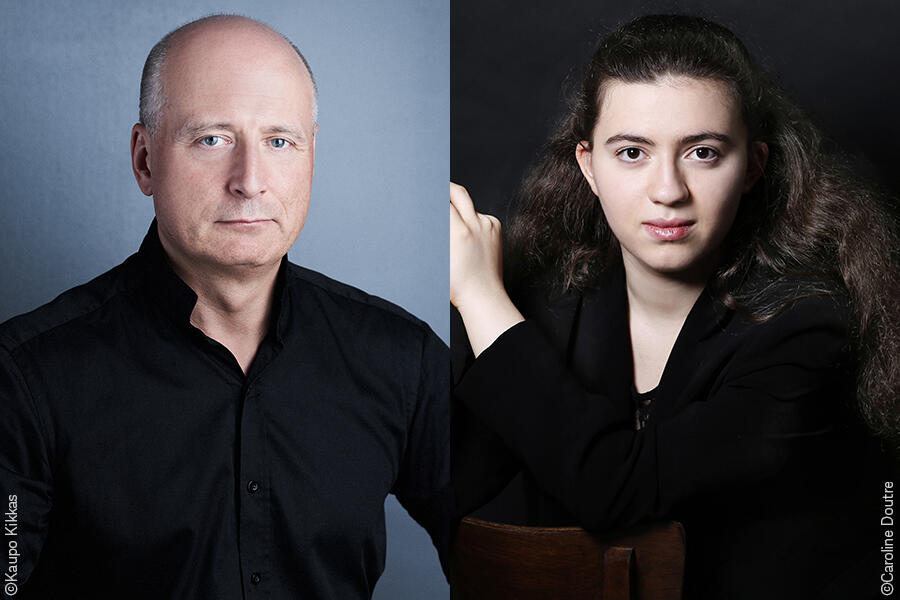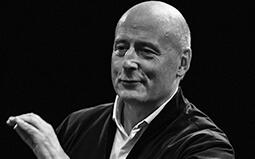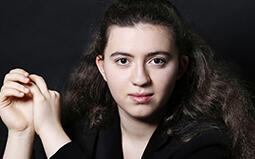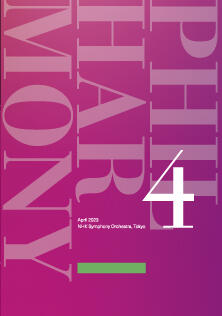- Home
- Concerts
- Subscription Concerts 2022-2023
- Program B
- No. 1982 Subscription (Program B)
No. 1982 Subscription (Program B)
Suntory Hall
Google Map Seating Chart

Program
Sibelius / Symphony No. 4 A Minor Op. 63
The timeless pride of Finland, Sibelius had established his international reputation even during his lifetime. In the field of the tone poem, he used subjects rooted in the Finnish culture to create masterpieces including Finlandia (1899/1900). The composer, an excellent violinist as well, also explored his individual style as a symphonist. Among his seven completed symphonies, the best-known may be the grandioso Second (1901), while the Fourth (1911) is conspicuous for its refined and somewhat modern writing, compactness, introspectiveness and transparent orchestration.
The introverted tone of the Fourth is commonly associated with Sibelius' private life, for he had a malignant tumor removed a year before starting to write it in 1909. Since the surgery, he feared the recurrence of cancer and thus faced mortality. At the time, his creative life went also critical, as he was groping for his own language between the late-Romantic luxurious orchestral sound of R. Strauss/Mahler and the avant-gardism of Stravinsky/Schönberg.
The Fourth is atypically in a slow-fast-slow-fast form. The first movement is a flexible sonata in A minor. During its introduction, Sibelius presents a motif with four notes (C/D/F-sharp/E) comprising a tritone (three whole-tones), the dissonant interval once called "diabolus(devil) in musica." This inauspicious motif would generate many themes of the symphony. The second scherzo-like movement, in F major, has a three-meter main section and a brief two-meter trio (central section). Though beginning with a blithe oboe melody (including the tritone motif), the music grows dark and ends all too soon with timpani. Of the whole work, the ruminative third movement in C-sharp minor takes the most elusive form. Its sonorous ascending theme becomes apparent in the cellos beneath upper strings’ tremolo, only after the fragments hint it for a space of thirty-eight measures. The finale in A–B–A–B form opens in A major with violins giving the impish main theme. Passing by the dissonant peak, Sibelius' shadowy symphony concludes with the weighty A-minor tonic chord repeated by strings alone.
[Kumiko Nishi]
Rakhmaninov / Rhapsody on a Theme of Paganini Op. 43*
The Italian composer Niccolò Paganini (1782–1840) was a phenomenal violinist. His technical prowess was such that, a rumor widespread that he had traded his soul for the magical talent with Devil. Rakhmaninov enjoyed an extraordinary virtuosity as well, as a pianist. He wrote Op. 43 for piano—thus for himself—and orchestra in 1934, as one of the few works he created since he left Russia following the 1917 Revolution.
Op. 43 is composed of a theme and twenty-four variations performed continuously. Though entitled "Rhapsody" (an episodic, single-movement form), it is designed in the traditional concerto format with a rapid movement (1st variation to 10th), a slow movement (11th to 18th) and a rapid finale (19th to 24th). After a short introduction, Rakhmaninov unconventionally inserts the 1st variation before violins present the theme, a brisk tune from Paganini's Caprice No. 24 for violin. Pivotal is the sluggish 7th variation, where the demonic Dies Irae (Day of Wrath) melody from the Catholic Mass for the Dead is first stated by the piano. The 18th variation gives the most romantic, mellifluous melody the composer ever wrote probably, inverting the theme. The piano ensures the theme's return at the 23rd variation before giving a brief cadenza-like passage without orchestra. The torrential 24th variation resounds the Dies Irae melody in the brass while the piano demonstrates its supreme virtuosity. Rakhmaninov's last concerto evaporates like a mischievous wink with a fleeting coda.
[Kumiko Nishi]
Tchaikovsky / Francesca da Rimini, symphonic fantasy after Dante, Op. 32
Francesca da Rimini actually existed in the 13th century. This Italian high-born lady was forced to marry Giovanni, the son of a lord, who ended up killing her when he discovered her having an affair with his brother Paolo. Her contemporary, Dante Alighieri immortalized her in his highly-praised Canto V of Inferno (from Divina commedia [Divine Comedy]) which has inspired countless art works, Tchaikovsky's 1876 version performed today being the most well-known musical adaptation. The Russian composer stayed in Bayreuth in 1876 for the premiere of Ring Cycle of Wagner whose influence on the former's Francesca da Rimini is often pointed out.
The work consists of an introduction and three sections played continuously. The "lugubrious" (according to Tchaikovsky) introduction is harmonically instable. It evokes Dante footslogging in a somber wood: he passes the gate to Hell with the famous inscription "Abandon all hope, ye who enter here." The rapid section 1 in E minor describes endlesslysuffering sinners Dante encounters. The descending main theme is blew by trumpets at the zenith before the clarinet’s monologue-like melody is heard. The section 2 features Francesca's soul relating about her sweet memory with Paolo (Andante). Then the horn warning leads to the unexpected, brief murder scene (Allegro). The section 3 in E minor lets the main theme return. Full of frightening rhythms and chords, the ending portrays the two lustful sinners' spirits snatched away in the hellish whirlwind for eternal agony.
[Kumiko Nishi]
Artists
 ConductorPaavo Järvi
ConductorPaavo Järvi
Paavo Järvi is from a musical family, his father being the famous conductor Neeme Järvi and his brother Kristjan is also a conductor. He has continuously held important positions directing renowned orchestras around the world, including the Cincinnati Symphony Orchestra, the Frankfurt Radio Symphony Orchestra and the Orchestre de Paris. He is currently Music Director of the Tonhalle Orchestra of Zurich. He was Chief Conductor of the NHK Symphony Orchestra from September 2015 to the 2021–22 season, and has been Honorary Conductor since September last year. He has also contributed to the development of classical music in Estonia, his homeland. It was with his performances of Beethoven symphonies that he first received worldwide acclaim, in his Beethoven Project with the Deustche Kammerphilharmonie Bremen of which he has been Artistic Director since 2004. His particular style, which combines an energetic pace with perfect articulation and powerful intonation, has been so innovative that set a new standard of Beethoven performance in the 21st century. However, it can also be said that he is a conductor who has built up a vast range of repertoire by having a flexible outlook. His approach to music, leaning towards clear sonorities and depicting the overall picture in just right way, may give an indication of where music of this global era should be. His musicality which can be described as a cosmopolitan style has resonated well with the NHK Symphony Orchestra, thus he and the orchestra have continued to display the essence of a wide range of works from the late Romantic period to the modern and contemporary eras as well as hidden Estonian works and Takemitsu with exquisite ensemble in sharp contrast. On this visit, he will conduct three attractive programs—one featuring R. Strauss works, which has been postponed since May 2020, as well as those with Scandinavian, Russian and French repertoire.
[Paavo Järvi by Mitsunori Eto, music critic]
 PianoMarie-Ange Nguci*
PianoMarie-Ange Nguci*
Born in Albania in 1997, Marie-Ange Nguci entered the Conservatoire National Supérieur de Musique et de dance de Paris (CNSMDP) at the age of 13 to study piano under the tutelage of Nicholas Angelich. She then has completed a doctoral course in musicology and musical analysis at the CNSMDP as well as a master's degree at the Sorbonne. She has been awarded 1st Prize at the MacKenzie Awards International Piano Competition at the International Keyboard Institute and Festival in New York (IKIF) in 2015 and the Grand Jury Prize of the Geneva Arts Society in 2018. She speaks seven languages and has been introduced in One Young World in the French edition of Vanity Fair as one of the young people who will change the world. Her first album En Miroir, released in 2017 has won high acclaim from French magazines. She has been working with the Orchestre de Paris, the BBC Symphony Orchestra, the Danish National Symphony Orchestra in recent years, and has been scheduled to appear with the Sydney Symphony Orchestra, the RAI National Symphony Orchestra, the Basel Chamber Orchestra and the Belgian National Orchestra in the 2022–23 season. She has brilliant and unconstrained musicality and enjoys a wide repertoire ranging from baroque to contemporary pieces which are rarely performed. Her first visit to Japan was in 2018 when she appeared in La Folle Journée Tokyo, and this is her first collaboration with the NHK Symphony Orchestra.
[Marie-Ange Nguci by Haruka Kosaka, music journalist]
Download
Ticket
Program B
No. 1982 Subscription (Program B)
Suntory Hall
Google Map
Seating Chart
Single Tickets Release Date
Pre-sales for Subscribers:Wednesday, March 1, 2023
*about subscribers
Sale to General Public:Sunday, March 5, 2023
Price
| S | A | B | C | D | |
|---|---|---|---|---|---|
| Ordinary Ticket | 9,800 | 8,400 | 6,700 | 5,400 | 4,400 |
| Youth Ticket | 4,500 | 4,000 | 3,300 | 2,500 | 1,800 |
Seating chart Enlarge Print PDF
*tax included
*About Youth tickets (Available at N-Kyo Guide)
*Subscribers receive a 10% discount (Available at NHKSO WEB Ticket and N-Kyo Guide)
*For wheelchair-accessible seats, please refer to the N-Kyo Guide
Starting Dates of Ticket Sales
ANNUAL SUBSCRIPTION TICKETS Mon., July 18, 2022 11:00am
[For Subscribers: Thu., July 14, 2022 11:00am]
Youth Tickets
Youth Tickets are great options for those of 25 years old and younger
WEB Select 3 Plus
Choose three or more of your favorite concerts and get a discount on single tickets
*Only available at NHKSO WEB Ticket NHKSO WEB Ticket (Accesible from Japan only)
For further information and subscription application
N-Kyo Guide TEL:0570-02-9502
Broadcast
 NHK-FMNo. 1982 Subscription (Program B)
NHK-FMNo. 1982 Subscription (Program B)
Saturday, May 6, 2023 4:00PM - 5:50PM
Program:
Sibelius / Symphony No. 4 A Minor Op. 63
Rakhmaninov / Rhapsody on a Theme of Paganini Op. 43*
Tchaikovsky / Francesca da Rimini, symphonic fantasy after Dante, Op. 32
Conductor:Paavo Järvi
Piano:Marie-Ange Nguci*
Recorded:April 26, 2023 Suntory Hall


